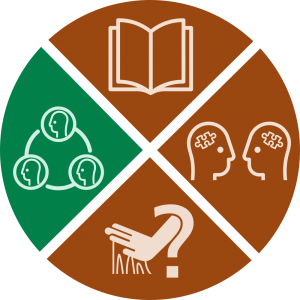
Interpretive Wheel – Leveraging Your Skills
[This content originally appeared on the NPS Common Learning Portal in June 2019]
A Model for Leveraging Your Skill
How can you tell something’s working? Where does it need improvement?
The Interpretive Wheel model is a tool to help you know what to look for in Audience Centered Experiences. The four categories help to describe the observable elements of 21st century interpretation. Every Audience Centered Experience has a mixture of the four elements. An individual experience may lean more heavily on a particular element, but all four should be present, with all participants (interpreter AND visitor, in person OR not) contributing to each element.
Everybody…
…Tells a Great Story
Stories are the center of our places – they provide the power of the parks and sites we interpret. But interpreters aren’t the only ones with powerful stories to share. That means visitors should have a chance to share stories, too – connecting their own life experiences intellectually and emotionally to the stories of your place.
…Invites Sharing
Curiosity, release, and adventure draw us to parks. Good invitations bring us deeper into the transformative experience we seek. Asking and answering questions allows people to express themselves and to engage more fully. The best dialogic questions help probe not content knowledge, but into the deep, universal human experiences we all share.
…Learns From & With Others
Cross-pollination helps build community. And good ACE experiences allow everybody to learn from everybody else. When we share our knowledge, visitors learn about the park. When visitors share, they also learn about themselves, about the experience of others, and about the world around them. And we, in turn, learn different ways people think and feel about our parks.
…Grapples with a Sticky Problem
Parks can be useful places for reflection and learning – to wrestle with big problems facing our society today. This is what helps our parks to be relevant – they bring us to new spaces physically, emotionally, intellectually, and spiritually. These new spaces can help us to solve problems and make better decisions in our everyday lives.
Mapping the Wheel to the Foundations of Interpretation Competencies
But what about the competencies described in the Foundations of Interpretation? The Interpretive Wheel model was designed to help you build your skills and recognize success as you craft 21st century interpretive experiences. These categories are based off of the description of success from the Foundations documents, but are a little easier to wrap your hands around. How do they align?
The “…Tells a Great Story” and “…Grapples with a Sticky Problem” quadrants of the Interpretive Wheel help to build your skills in the Site Research & Relevance competency. These parts of the wheel focus on how you find the stories we tell, how you encourage others’ perspectives as we explore our sites, and how you can tie your interpretive experiences to relevant issues.
The “…Invites Sharing” and “…Learns From & With Others” quadrants of the Interpretive Wheel help exercise your skills in the Building Audience and Community competency. These parts of the wheel focus on how you interact with visitors, how you create spaces that welcome their expression, and how you value their perspectives.
All four of the parts of the wheel help you build your skills in the Self-Awareness & Bias and Designing Visitor Experience competencies. These skill sets are crosscutting in a few ways. Each element of the wheel helps you reflect not only on what you do, but how your perspectives and biases influence your works as an interpreter. Each element of the wheel is also crucial as you craft experiences for visitors within your park.
The ACE Wheel Model appears as originally drafted in June 2019. It was developed by an employee of the US federal government, made during the course of the person's official duties. As a work of the U.S. federal government, it is in the public domain.








